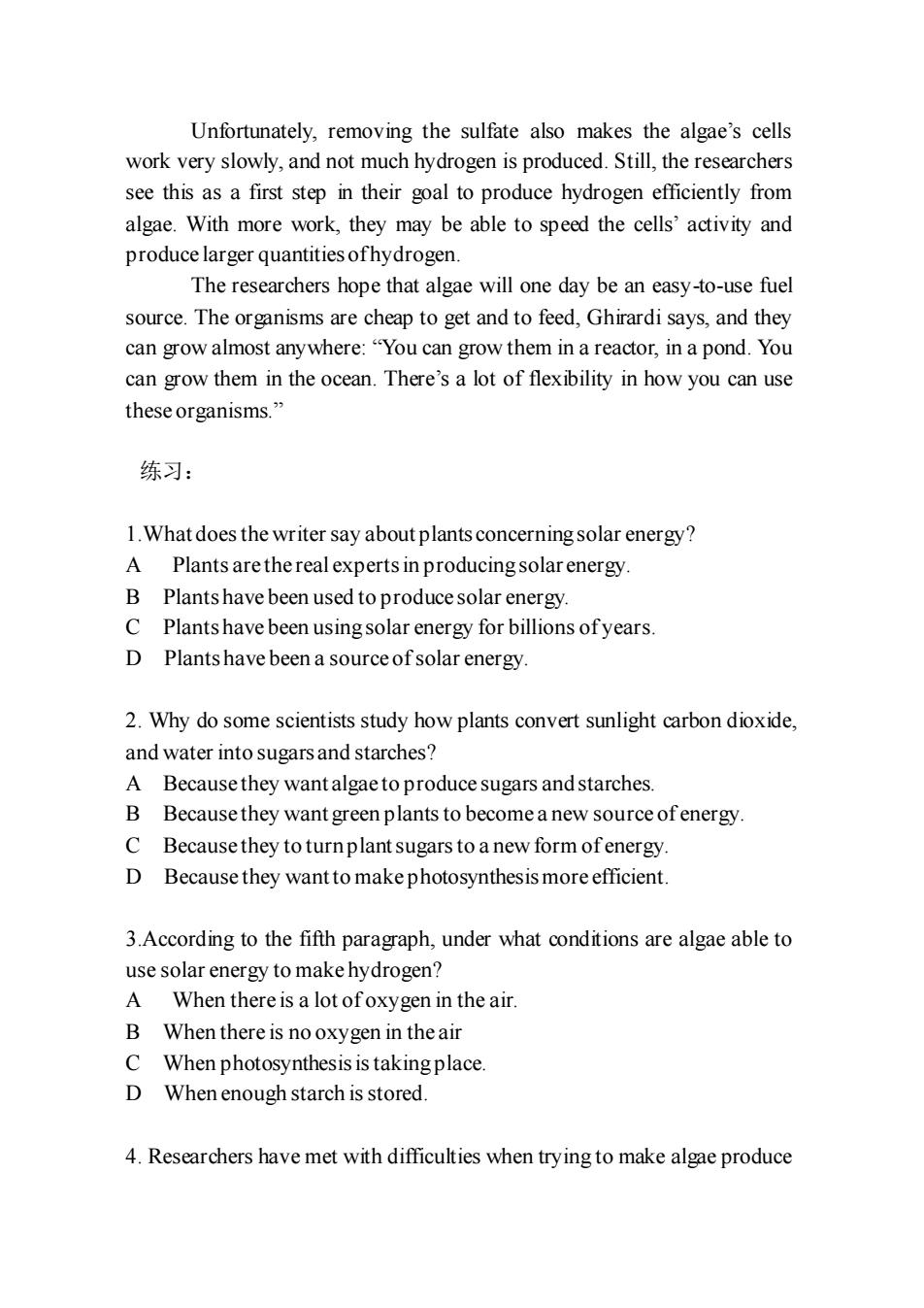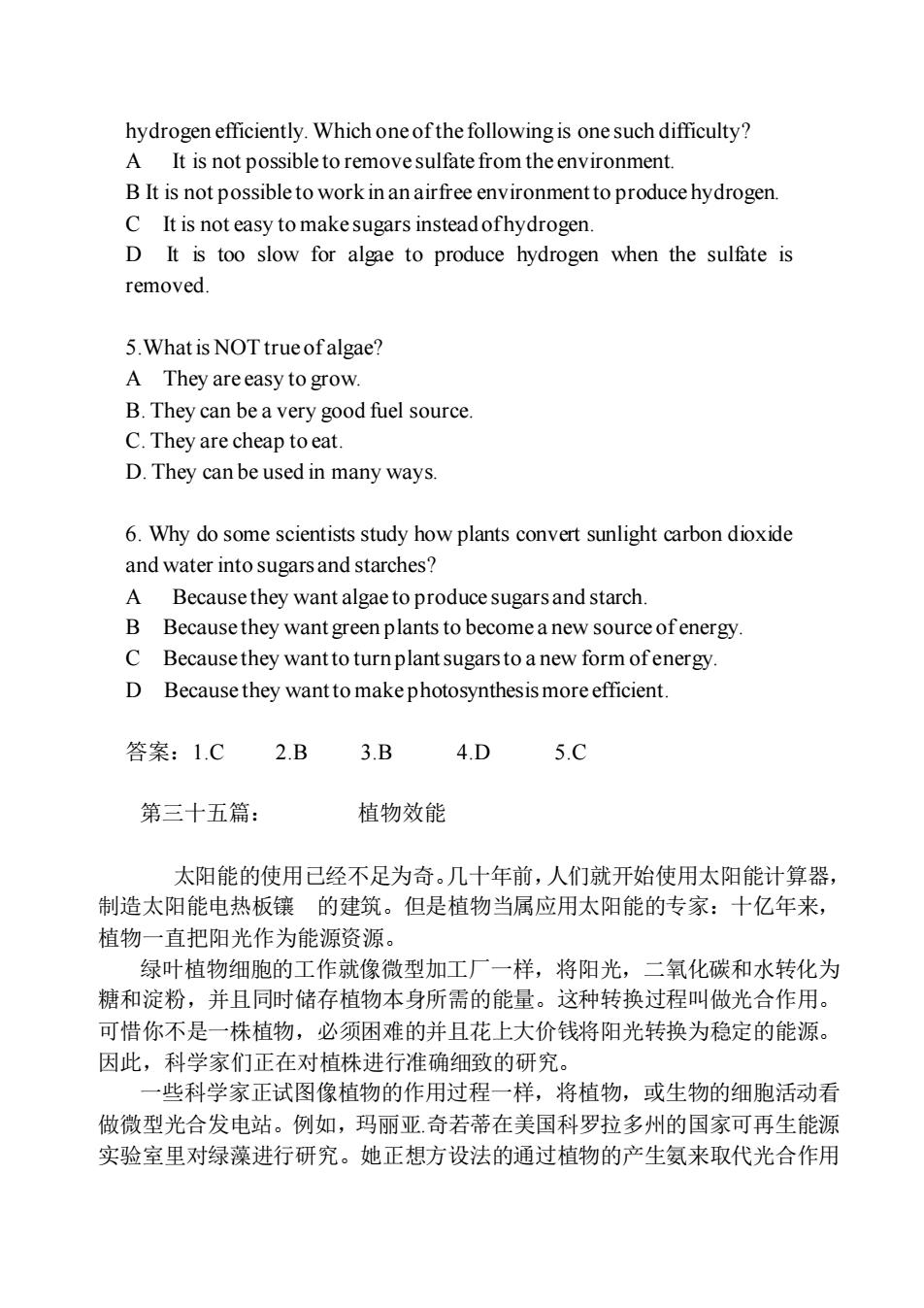
第三十五课:PuttingPlantstoWork原书出题有错6题答案5题(理工174p)(B级)Using the power of the sun is nothing new. People have hadsolar-powered calculators and buildings with solar panels for decades.Butplants are the real experts: They've been using sunlight as an energysourceforbillionsofyears.Cells in the green leaves of plants work like tiny factories toconvert sunlight, carbon dioxide, and water into sugars and starches.stored energy that plants can use. This conversion process is calledphotosynthesis. Unfortunately, unless you're a plant, it's difficult andexpensive to convert sunlight into storable energy. That's why scientistsaretakinga closer look at exactly how plants do it.Some scientists are trying to get plants, or biological cells that actlike plans, to work as miniature photosynthetic power stations. Forexample, Maria Ghirardi of the National Renewable Energy Laboratory inGolden, Colo.,is working with green algae. She's trying to trick them intoproducing hydrogen instead of sugars when they perform photosynthesis.Once the researchers can get the algae working efficiently, the hydrogenthat they produce could be used to power fuel cells in cars or to generateelectricity.The algae are grown in narrow-necked glass bottles to producehydrogen in the lab. During photosynthesis, plants normally make sugarsor starches.“But under certain conditions, a lot of algae are able to use thesunlight energy not to store starch, but to make hydrogen." Ghirardi says.For example,algae will producehydrogen in an airfree environment.It'sthe oxygen in the air that prevents algae from making hydrogen most ofthetime.Working in an airfree environment, however, is difficult. It's not apractical way to produce cheap energy. But Ghirardi and her colleagueshave discovered that by removing a chemical called sulfate from theenvironment that the algae grow in, they will make hydrogen instead ofsugars,even when air is present
第三十五课: Putting Plants to Work 原书出题有错 6 题 答案 5 题 (理工 174p)(B 级) Using the power of the sun is nothing new. People have had solar-powered calculators and buildings with solar panels for decades. But plants are the real experts: They’ve been using sunlight as an energy source for billions of years. Cells in the green leaves of plants work like tiny factories to convert sunlight, carbon dioxide, and water into sugars and starches, stored energy that plants can use. This conversion process is called photosynthesis. Unfortunately, unless you’re a plant, it’s difficult and expensive to convert sunlight into storable energy. That’s why scientists are taking a closer look at exactly how plants do it. Some scientists are trying to get plants, or biological cells that act like plans, to work as miniature photosynthetic power stations. For example, Maria Ghirardi of the National Renewable Energy Laboratory in Golden, Colo. , is working with green algae. She’s trying to trick them into producing hydrogen instead of sugars when they perform photosynthesis. Once the researchers can get the algae working efficiently, the hydrogen that they produce could be used to power fuel cells in cars or to generate electricity. The algae are grown in narrow-necked glass bottles to produce hydrogen in the lab. During photosynthesis, plants normally make sugars or starches. “But under certain conditions, a lot of algae are able to use the sunlight energy not to store starch, but to make hydrogen.” Ghirardi says. For example, algae will produce hydrogen in an airfree environment. It’s the oxygen in the air that prevents algae from making hydrogen most of the time. Working in an airfree environment, however, is difficult. It’s not a practical way to produce cheap energy. But Ghirardi and her colleagues have discovered that by removing a chemical called sulfate from the environment that the algae grow in, they will make hydrogen instead of sugars, even when air is present

Unfortunately, removing the sulfate also makes the algae's cellswork very slowly, and not much hydrogen is produced. Still, the researcherssee this as a first step in their goal to produce hydrogen efficiently fromalgae. With more work, they may be able to speed the cells' activity andproduce larger quantities ofhydrogen.The researchers hope that algae will one day be an easy-to-use fuelsource. The organisms are cheap to get and to feed, Ghirardi says, and theycan grow almost anywhere: “You can grow them in a reactor, in a pond. Youcan grow them in the ocean. There's a lot of flexibility in how you can usetheseorganisms."练习:1. What does the writer say about plants concerning solar energy?APlants are thereal experts in producing solar energy.B Plants have been used to produce solar energy.CPlants havebeen usingsolar energyforbillions ofyears.D Plantshave been a sourceof solar energy.2. Why do some scientists study how plants convert sunlight carbon dioxide,and water into sugars and starches?Becausethey wantalgaeto produce sugars and starchesABBecausethey want green plants to become a new source of energyC Because they to turnplant sugars to a new form ofenergy.DBecause they wantto makephotosynthesis more efficient.3.According to the fifth paragraph, under what conditions are algae able touse solar energy to make hydrogen?AWhen there is a lot of oxygen in the air.BWhen there is no oxygen in the airCWhen photosynthesis is takingplace.DWhen enough starch is stored.4. Researchers have met with difficulties when trying to make algae produce
Unfortunately, removing the sulfate also makes the algae’s cells work very slowly, and not much hydrogen is produced. Still, the researchers see this as a first step in their goal to produce hydrogen efficiently from algae. With more work, they may be able to speed the cells’ activity and produce larger quantities of hydrogen. The researchers hope that algae will one day be an easy-to-use fuel source. The organisms are cheap to get and to feed, Ghirardi says, and they can grow almost anywhere: “You can grow them in a reactor, in a pond. You can grow them in the ocean. There’s a lot of flexibility in how you can use these organisms.” 练习: 1.What does the writer say about plants concerning solar energy? A Plants are the real experts in producing solar energy. B Plants have been used to produce solar energy. C Plants have been using solar energy for billions of years. D Plants have been a source of solar energy. 2. Why do some scientists study how plants convert sunlight carbon dioxide, and water into sugars and starches? A Because they want algae to produce sugars and starches. B Because they want green plants to become a new source of energy. C Because they to turn plant sugars to a new form of energy. D Because they want to make photosynthesis more efficient. 3.According to the fifth paragraph, under what conditions are algae able to use solar energy to make hydrogen? A When there is a lot of oxygen in the air. B When there is no oxygen in the air C When photosynthesis is taking place. D When enough starch is stored. 4. Researchers have met with difficulties when trying to make algae produce

hydrogen efficiently.Which one ofthe following is one such difficulty?AItisnotpossibletoremovesulfatefromtheenvironmentBIt is not possibleto work inan airfree environmenttoproducehydrogenCIt is noteasyto make sugars insteadofhydrogen.D It is too slow for algae to produce hydrogen when the sulfate isremoved.5.What is NOT trueofalgae?ATheyareeasytogrow.B. They can be a very good fuel sourceC. They are cheap to eatD. They can be used in many ways.6. Why do some scientists study how plants convert sunlight carbon dioxideand water into sugarsand starches?ABecausethey wantalgaeto produce sugarsand starchBBecausetheywantgreenplants to becomea new sourceof energyCBecausethey wantto turn plant sugars to a new form of energy.DBecausethey wanttomakephotosynthesismoreefficient.答案:1.C2.B3.B4.D5.C第三十五篇:植物效能太阳能的使用已经不足为奇。几十年前,人们就开始使用太阳能计算器制造太阳能电热板镶的建筑。但是植物当属应用太阳能的专家:十亿年来,植物一直把阳光作为能源资源。绿叶植物细胞的工作就像微型加工厂一样,将阳光,二氧化碳和水转化为糖和淀粉,并且同时储存植物本身所需的能量。这种转换过程叫做光合作用。可惜你不是一株植物,必须困难的并且花上大价钱将阳光转换为稳定的能源。因此,科学家们正在对植株进行准确细致的研究。一些科学家正试图像植物的作用过程一样,将植物,或生物的细胞活动看做微型光合发电站。例如,玛丽亚.奇若蒂在美国科罗拉多州的国家可再生能源实验室里对绿藻进行研究。她正想方设法的通过植物的产生氨来取代光合作用
hydrogen efficiently. Which one of the following is one such difficulty? A It is not possible to remove sulfate from the environment. B It is not possible to work in an airfree environment to produce hydrogen. C It is not easy to make sugars instead of hydrogen. D It is too slow for algae to produce hydrogen when the sulfate is removed. 5.What is NOT true of algae? A They are easy to grow. B. They can be a very good fuel source. C. They are cheap to eat. D. They can be used in many ways. 6. Why do some scientists study how plants convert sunlight carbon dioxide and water into sugars and starches? A Because they want algae to produce sugars and starch. B Because they want green plants to become a new source of energy. C Because they want to turn plant sugars to a new form of energy. D Because they want to make photosynthesis more efficient. 答案:1.C 2.B 3.B 4.D 5.C 第三十五篇: 植物效能 太阳能的使用已经不足为奇。几十年前,人们就开始使用太阳能计算器, 制造太阳能电热板镶 的建筑。但是植物当属应用太阳能的专家:十亿年来, 植物一直把阳光作为能源资源。 绿叶植物细胞的工作就像微型加工厂一样,将阳光,二氧化碳和水转化为 糖和淀粉,并且同时储存植物本身所需的能量。这种转换过程叫做光合作用。 可惜你不是一株植物,必须困难的并且花上大价钱将阳光转换为稳定的能源。 因此,科学家们正在对植株进行准确细致的研究。 一些科学家正试图像植物的作用过程一样,将植物,或生物的细胞活动看 做微型光合发电站。例如,玛丽亚.奇若蒂在美国科罗拉多州的国家可再生能源 实验室里对绿藻进行研究。她正想方设法的通过植物的产生氨来取代光合作用

产生糖。一旦研究人员了解藻类如何有效率的进行工作,由此产生的氨气可用于燃料电池动力汽车和发电。在实验室里,藻类生长通过狭窄的颈玻璃瓶生产氨气的环境下。在光合作用下,植物通常产生糖类或淀粉。奇若蒂说:“但在一定条件下,有很多藻类能够利用日光能源产生氨气而不是储存淀粉。”例如,藻类会在空气存在环境下产生氨气。这事因为空气中的氧气,氧阻止绿藻制造氨。藻类在空气中虽然可以工作,但是充满困难。这种方式不能切实可行的生产廉价的能源。但是奇若蒂和她的同事们已经发现,即使在目前的空气条件下,他们从藻类生长的环境中,除去所谓的硫酸化学品,能够产生氨来代替糖。只可惜消除硫酸盐不仅使藻类细胞的工作速度减慢,而且大大减少了氨的数量。尽管如此,研究人员认为,对于实现有效率的利用藻类产生氨这一目标,他们已经迈出了第一步。随着工作量的加大,他们可以加速细胞的活动,从而产生大量的氨气。研究人员们希望,总有一天藻类会成为很容易使用的燃料来源。藻类这种生物极易存活,他们可以在几乎任何地方成长。奇若蒂说:“你可以将它放在反应堆或是池塘里,也可以在海洋中找到它们,人们可以灵活的使用藻类的用途广泛
产生糖。一旦研究人员了解藻类如何有效率的进行工作,由此产生的氨气可用 于燃料电池动力汽车和发电。 在实验室里,藻类生长通过狭窄的颈玻璃瓶生产氨气的环境下。在光合作 用下,植物通常产生糖类或淀粉。奇若蒂说:“但在一定条件下,有很多藻类能 够利用日光能源产生氨气而不是储存淀粉。”例如,藻类会在空气存在环境下产 生氨气。这事因为空气中的氧气,氧阻止绿藻制造氨。 藻类在空气中虽然可以工作,但是充满困难。这种方式不能切实可行的生 产廉价的能源。但是奇若蒂和她的同事们已经发现,即使在目前的空气条件下, 他们从藻类生长的环境中,除去所谓的硫酸化学品,能够产生氨来代替糖。 只可惜消除硫酸盐不仅使藻类细胞的工作速度减慢,而且大大减少了氨的 数量。尽管如此,研究人员认为,对于实现有效率的利用藻类产生氨这一目标, 他们已经迈出了第一步。随着工作量的加大,他们可以加速细胞的活动,从而 产生大量的氨气。 研究人员们希望,总有一天藻类会成为很容易使用的燃料来源。藻类这种 生物极易存活,他们可以在几乎任何地方成长。奇若蒂说:“你可以将它放在一 反应堆或是池塘里,也可以在海洋中找到它们,人们可以灵活的使用藻类的用 途广泛